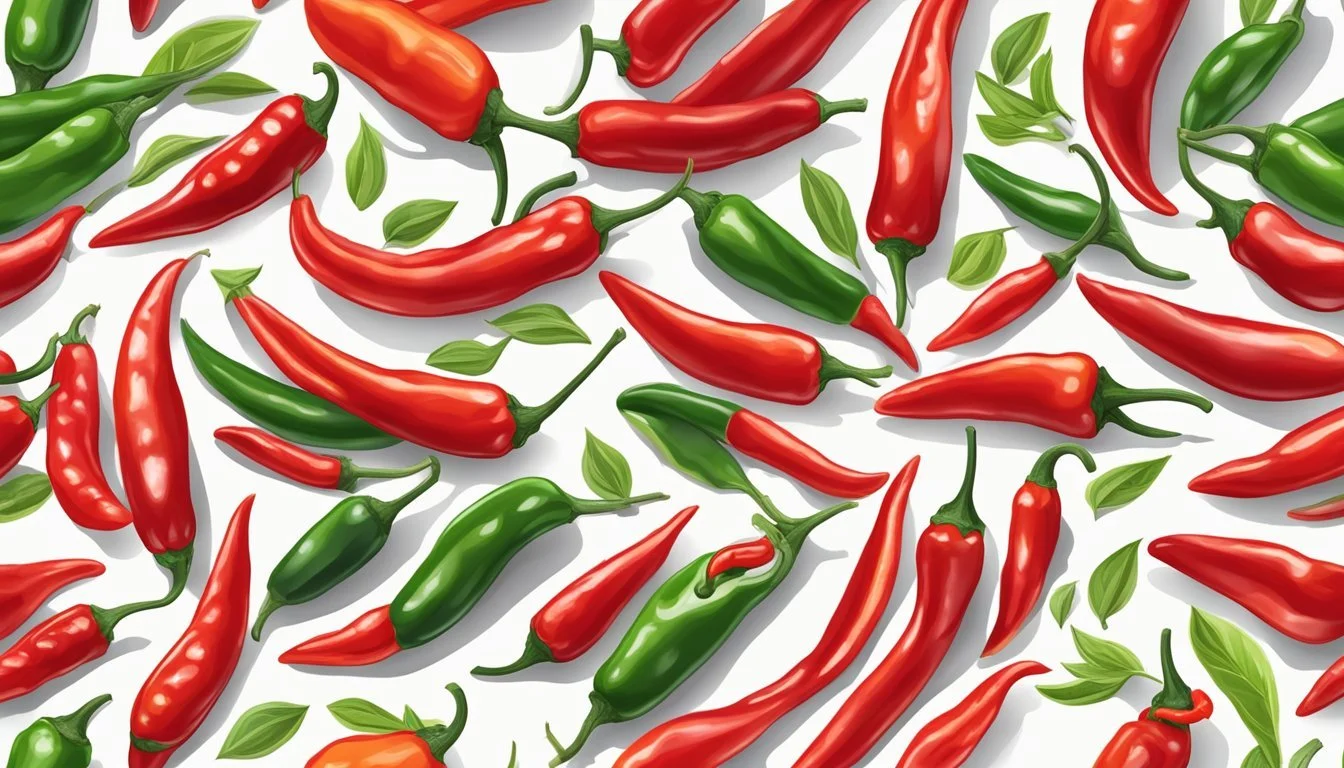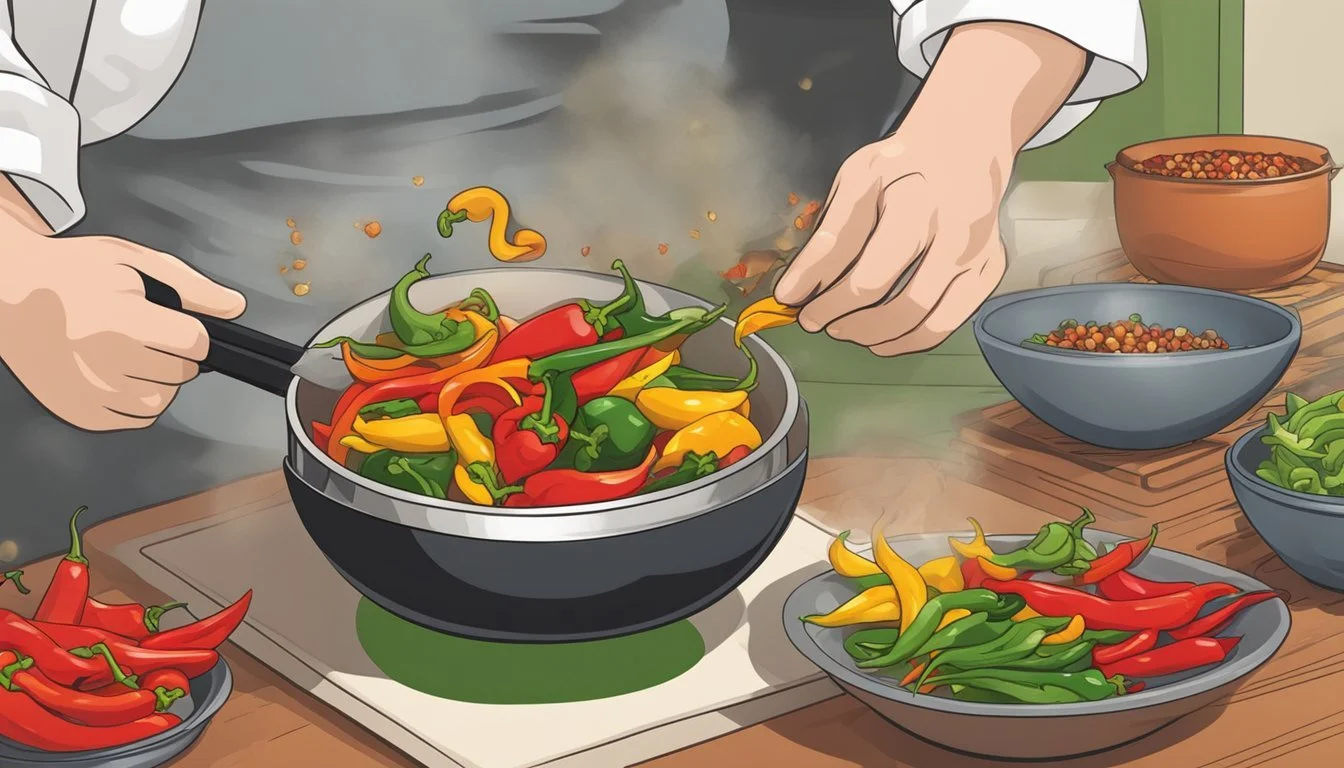Thai Chili Peppers Substitutes
Best Alternatives for Varied Heat Levels
Searching for the perfect substitute for Thai chili peppers can be a quest for anyone passionate about authentic Thai cooking. Whether you’ve run out or simply can’t find them locally, alternatives like red serrano peppers or chili garlic sauce are excellent options. Not only do these substitutes bring the necessary heat, but they also add unique flavors that can elevate your dishes.
For those who crave a similar heat level, using Chile de Arbol or cayenne pepper can be effective. Chile de Arbol offers a nutty, smoky flavor, while cayenne provides flexibility with its medium-heat punch. These alternatives ensure that the spiciness remains, making them practical substitutes for various Thai recipes.
Sometimes, a milder alternative is preferred for those who can't handle intense spiciness. Thai Prik Chi Fah is a great option, offering a milder heat while still allowing for a delicious flavor profile. Using Italian Sweet Pepper, Mild Anaheim, or Poblano can help adjust the heat to your preference without compromising the essence of Thai cooking.
Understanding Thai Chili Peppers
Thai chili peppers are known for their vibrant heat and indispensable role in Thai cuisine. They vary in heat levels and offer unique flavors that contribute to the spiciness and complexity of many Thai dishes.
Characteristics of Thai Chilies
Thai chilies, often small and fiery, come in different varieties. Common types include bird’s eye chili, which is thin, small, and green or red in color. These chilies have a sharp, intense heat and a slight fruity undertone. Another variety is the Thai Prik Chi Fah, which is larger and milder. Both types are typically used fresh, dried, or ground into powders.
Scoville Scale and Heat Levels
The heat of Thai chili peppers is measured on the Scoville scale. Bird’s eye chilies range from 50,000 to 100,000 Scoville Heat Units (SHU), placing them in the same category as habanero or scotch bonnet peppers. Thai Prik Chi Fah chilies are much milder, with a heat range of approximately 1,000 to 5,000 SHU. This section illustrates the wide spectrum of spiciness found in Thai chilies.
Common Uses in Thai Cuisine
Thai chilies are a fundamental component of many Thai dishes. Bird’s eye chilies are essential in making Thai curries such as green and red curries, adding a signature heat. They are also used in spicy salads like som tam (papaya salad) and dipping sauces like nam prik. Milder varieties, like Thai Prik Chi Fah, feature prominently in stir-fries and soups, offering a balanced heat without overwhelming the dish.
Nutritional Profile
Thai chili peppers are not just about heat; they are rich in nutrients. They are an excellent source of vitamins A and C, which are vital for immune health and skin. Additionally, these chilies contain potassium, iron, and antioxidants. Capsaicin, the compound responsible for the spiciness, may have anti-inflammatory and metabolic-boosting properties, contributing positively to a balanced diet.
Substitutes for Thai Chili Peppers
When Thai chili peppers are unavailable, there are several alternatives that can match their heat and flavor. Each substitute offers a unique balance of spice and taste, allowing for flexibility in culinary creations.
Serrano Peppers: A Versatile Substitute
Serrano peppers offer a close match to Thai chili peppers regarding heat. They range from 10,000 to 23,000 Scoville Heat Units (SHU), making them a suitable substitute. Serranos are bright green, slender, and have a crisp texture. When fresh Thai chilies are not available, serrano peppers can be chopped and used in the same quantity.
Their slightly grassy flavor enhances salads, salsas, and stir-fries without overpowering other ingredients. Tip: When using in soups or stews, remember to remove the seeds to control the heat level.
Cayenne Pepper: Heat without the Bite
Cayenne pepper powder is a convenient substitute for Thai chili peppers. This powdered spice has a heat level ranging from 30,000 to 50,000 SHU. Although it lacks the fresh crispiness of whole peppers, cayenne pepper provides a consistent heat level. It is readily available and can be used in various dishes such as sauces, marinades, and dry rubs.
Cayenne pepper should be added in small increments, allowing the cook to achieve the desired spiciness. One benefit is its versatility, as it can blend seamlessly into liquids and dry mixtures.
Jalapeño Peppers: The Milder Option
Jalapeño peppers are a milder alternative to Thai chilies, with a heat level ranging from 2,500 to 8,000 SHU. They are thicker and larger than Thai chilies, but their flavor is appealingly fresh and slightly tangy. In recipes where intense heat is not required, jalapeños can be substituted in a 1:1 ratio.
Chopped fresh jalapeños work well in salsas, salads, and as a topping. When more heat is needed, consider combining jalapeños with a small amount of cayenne pepper or red pepper flakes.
Habanero Pepper: For the Heat Seekers
Habanero peppers are among the hottest pepper substitutes available, boasting a heat level between 100,000 and 350,000 SHU. Their fruity and floral notes offer a distinctive flavor, making them perfect for those who enjoy intense heat. Habaneros should be used sparingly, and it's advisable to wear gloves when handling them to avoid skin irritation.
Add them to dishes such as hot sauces, spicy salsas, and stews for an extra punch. Since their heat can be overwhelming, incorporating small amounts initially and adjusting according to taste is recommended.
Specialty Peppers as Alternatives
When Thai chili peppers are unavailable, specialty peppers can provide a similar flavor and heat profile. Here are some unique alternatives to consider, each offering distinct characteristics and heat levels that can closely mimic Thai peppers.
Prik Kee Nok and Prik Yuak: Thai Variants
Prik Kee Nok, known as bird’s eye chili pepper, is an excellent Thai pepper substitute. It is small and intensely hot, adding a vibrant heat to dishes. With a Scoville rating between 50,000 and 100,000 SHU, it delivers significant spiciness.
Prik Yuak, or spur chili, offers a milder heat. These peppers, with around 1,000 SHU, can be used when a less intense flavor is desired. Their mild spice and bright color make them versatile for various Thai recipes.
Chiltepin Pepper: The Wild Choice
Chiltepin peppers, often referred to as the mother of all peppers, offer a distinct wild, smoky flavor. These tiny yet potent peppers measure between 50,000 and 100,000 SHU on the Scoville scale.
Their small size makes them ideal for adding bursts of heat to salsas, stews, and sauces. They can be used fresh or dried, providing a unique, slightly smoky taste that contrasts well with Thai dishes.
Pequin and Piri-Piri: Small but Fiery
Pequin peppers are tiny but deliver a powerful punch, ranging from 30,000 to 60,000 SHU. Often dried and used in chili powders, they have a slightly citrusy taste, adding complexity to recipes.
Piri-Piri (or Peri-Peri) peppers, known for their use in African and Portuguese cuisines, have a Scoville rating between 50,000 to 175,000 SHU. Their fiery heat and fruity undertones make them a great stand-in for Thai chilies.
Indian Finger Hot Peppers: Exotic Heat
Indian Finger Hot Peppers, also known as Jwala peppers, provide an exotic heat level, ranging from 20,000 to 30,000 SHU. These peppers are slender and elongated, similar to some Thai varieties.
Their heat and slightly fruity flavor are well-suited for curries, pickles, and stir-fried dishes. They make an excellent substitute, bringing both spice and an authentic touch to Thai-inspired recipes.
Other Common Substitutes
Several substitutes can stand in for Thai chili peppers, each bringing unique flavors and heat levels to the dish. These alternatives range from completely mild options to those that pack a significant punch.
Bell Pepper: A No-Heat Variant
Bell peppers offer a mild and sweet flavor, making them ideal for those who want to avoid heat entirely. They are useful in dishes where color and crunch are important but not the spiciness.
These peppers come in various colors—red, yellow, green—and can be used raw in salads or cooked in stir-fries. While they lack the heat of Thai chili peppers, their versatility and accessibility make them a popular choice.
Red Pepper Flakes: The Pantry Staple
Red pepper flakes, also known as crushed red pepper, are a common pantry staple. Made from dried and crushed chili peppers, they can vary in heat but generally offer a moderate level of spiciness.
They work well as a substitute in soups, sauces, and toppings for pizzas and pasta. Measuring is straightforward: use roughly a quarter teaspoon for every Thai chili pepper called for.
Fresno and Tabasco Peppers: Unique Flavors
Fresno chili peppers provide a bright red color and a heat level that is milder than Thai chili peppers but hotter than bell peppers. Their fruity taste and moderate heat make them suitable for salsas, sauces, and pickling.
Tabasco peppers, on the other hand, range from 30,000 to 50,000 Scoville Heat Units (SHU). Used in Tabasco sauce, they add a tangy, intense heat that works well in hot sauces, marinades, and savory dishes.
Dried and Ground Options
Dried and ground chilis offer convenience and extended shelf life. Options like Chile de Arbol and cayenne pepper fall into this category. Chile de Arbol ranges from 15,000 to 30,000 SHU and has a smoky flavor, making it suitable for salsas and stews.
Cayenne pepper, with its 30,000 to 50,000 SHU, provides a comparable heat level to Thai chili peppers and brings a similar taste profile. These powders are easy to measure, with a quarter teaspoon roughly equating to one Thai chili pepper.
Integrating Substitutes in Cooking
Selecting the right Thai chili substitute can significantly impact your dishes, from adjusting heat levels to balancing flavors. Each alternative brings its unique characteristics to soups, stews, stir-fries, curries, and garnishes.
Adjustments for Heat in Recipes
Different chili substitutes vary greatly in heat. For example, serrano peppers are about four times milder than Thai chilis, making them suitable for those seeking less spice. Cayenne peppers (30,000 to 50,000 SHU) offer moderate heat, while Chile de Arbol provides a hotter alternative.
Adjust proportions carefully. Start with small amounts and increase based on taste preferences. For higher heat, Tabasco peppers might be more appropriate, bringing 30,000 to 50,000 SHU into the mix.
Creating Balances in Soups and Stews
In soups and stews, achieving a balanced flavor profile is crucial. Chile de Arbol or Red pequin peppers can be added to enhance both heat and smokiness.
Adding Chili Garlic Sauce incorporates both spice and the savory essence of garlic, ideal for Asian recipes. Use these substitutes sparingly to avoid overwhelming the dish.
Mixing different chili substitutes can create a complex heat profile that complements ingredients like vegetables and meats. Ensure to taste as you go to maintain balance.
Enhancing Flavors in Stir-Fries and Curries
For stir-fries and curries, select replacements that blend well with other strong flavors. Peri-peri can match Thai chili's intensity with a 1:1 ratio. Serrano peppers provide a milder, fresher option, letting other spices shine.
Incorporate substitutes early in stir-fries to meld the heat into the oil and vegetables. For curries, add peppers to the paste to infuse flavors deeply.
Chili Garlic Sauce can also be a beneficial alternative, adding both heat and depth. Adjust the quantity to suit the desired spice level.
Substitutes for Garnish and Salsas
When using chili substitutes for garnishes or salsas, appearance and texture matter. Red ripe serrano peppers offer a vibrant color and moderate heat, ideal for fresh salsas or as taco toppings.
Chili powder from dried pequin peppers can be sprinkled as a garnish, providing a fine texture. For fresh garnishes, Tabasco peppers can add a visual appeal with their bright red and yellow colors.
In salsas, experiment with different peppers like Chile de Arbol to combine heat with a nutty, smoky flavor, enhancing dishes without overpowering them.
Purchasing and Storage Tips
When looking for Thai chili pepper substitutes, it's crucial to find quality alternatives and know how to store them properly. This will ensure you have a reliable spice rack stocked with flavorful options when needed.
Finding Substitutes at Local and Online Stores
Many substitutes for Thai chili peppers can be found at specialty grocery stores or even well-stocked supermarkets. Look for fresh and dried varieties of peppers like serrano, cayenne, and chile de árbol in the produce or spice section.
Online retailers in the USA offer a broader selection. Websites like Amazon, specialty spice shops, or Asian grocery stores frequently stock a wide range of chili substitutes. Shopping online can provide access to harder-to-find varieties and bulk options, often at competitive prices.
Storing Fresh and Dried Peppers
Proper storage is essential for maintaining the flavor and heat of your pepper substitutes. Fresh peppers, such as serranos or cayenne, should be stored in a refrigerator crisper drawer. Place them in a breathable bag or container to prevent moisture buildup.
For dried peppers, like chile de árbol or dried pequin, store them in an airtight container in a cool, dark place, such as a pantry or spice rack. This helps preserve their potency and flavor. Consider using vacuum-sealed bags or jars to extend their shelf life significantly.
Extending Shelf Life of Substitutes
To prolong the shelf life of your chili substitutes, consider methods like freezing or making pastes and sauces. Fresh peppers can be sliced and frozen in airtight bags, preserving their heat for several months. Labeling bags with dates can help keep track of freshness.
For dried varieties, you can grind them into powders, creating a convenient and longer-lasting spice option. Keep these powders in tightly sealed containers, away from light and heat, to prevent degradation. Making chili pastes or sauces with garlic and oils can also extend usability while adding rich flavors to dishes.
By paying attention to purchase sources and storage methods, you can ensure your spice rack remains well-stocked with potent and flavorful Thai chili pepper substitutes.
Exploring Regional Varieties
Specific chili peppers from regions outside of Thailand can serve as excellent substitutes, offering unique flavors and heat levels. Understanding these options can enhance culinary experiences, whether aiming for the fiery punch of Thai cuisine or a slightly different taste profile.
Asian Varieties Beyond Thai Borders
Asian countries offer numerous chili options. In the Philippines, siling labuyo is a popular choice, providing intense heat. These small, red chilies rank between 80,000 to 100,000 Scoville Heat Units (SHU).
Korean gochugaru is another versatile option. It's typically used in dishes like kimchi. Gochugaru offers a medium heat level, around 4,000 to 8,000 SHU. Chinese cuisine often features dried Tien Tsin peppers, which add a sharp heat, around 50,000 to 75,000 SHU.
Central and South American Heat Sources
Chilies from Central and South America provide diverse flavors and heat. Chiles de Arbol are a prime example, used in Mexican cuisine for their smoky and nutty taste, with heat levels from 15,000 to 30,000 SHU.
Red pequin peppers also hail from Mexico and are often dried and ground into powder. They range from 30,000 to 50,000 SHU. The versatile Cayenne pepper is another option, offering between 30,000 to 50,000 SHU, providing a milder heat compared to Thai peppers but with a flavor that complements many dishes.
African Peppers and Their Distinctive Taste
African peppers are known for their distinctive heat and flavor profiles. Peri-peri peppers, originally from Mozambique, are a popular substitute. They carry between 50,000 to 175,000 SHU, offering significant heat and a slightly citrusy flavor.
Malagueta peppers, commonly used in Brazilian cuisine, provide intense heat, similar to peri-peri, ranging from 60,000 to 100,000 SHU.
North African Harissa is a spice blend that often includes various chili peppers, delivering a complex heat ideal for enhancing stews and meat dishes.
Indian and Middle Eastern Variants
India's Guntur Sannam chili pepper is a widely used alternative, known for its fiery heat, ranging from 35,000 to 40,000 SHU. It is commonly used in Indian curries and masalas.
In the Middle East, Aleppo peppers are popular. These offer a more moderate heat level, about 10,000 SHU, and a fruity, slightly tangy taste.
The Bird's Eye chili, used extensively in Indian and Southeast Asian cuisine, also serves as a good substitute. It provides a high heat level, between 100,000 to 225,000 SHU, often used to add significant spice to dishes.








